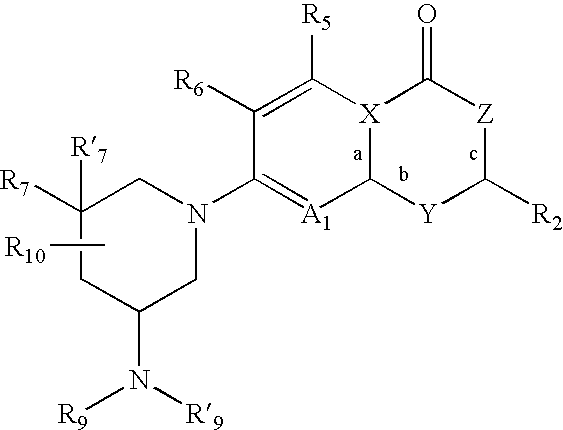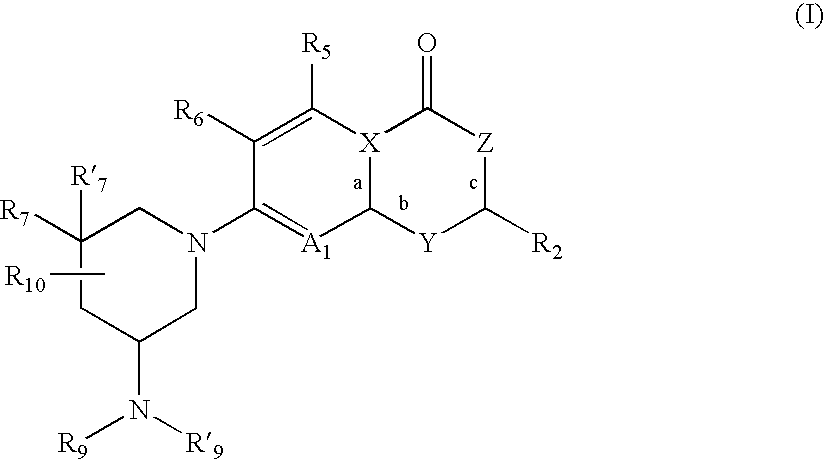Antimicrobial quinolones, their compositions and uses
a technology of quinolones and quinolones, applied in the field of antimicrobial compounds, can solve the problems of limited capacity of existing antibacterials to overcome the threat, few antimicrobials are produced that are truly clinically acceptable, and the threat to public health is significant in the developed world, and achieves a favorable clastogenecity profile
- Summary
- Abstract
- Description
- Claims
- Application Information
AI Technical Summary
Benefits of technology
Problems solved by technology
Method used
Image
Examples
example a
Precursor Example A
[0156]
3-methoxy-2,4,5-trifluorobenzoyl chloride
[0157]3-Methoxy-2,4,5-difluorobenzoic acid (43.9 g, 213 mmol) is suspended in dichloromethane (30 mL) and oxalyl chloride (25 mL, 287 mmol) is added followed by 4 drops of dry DMF. The mixture is stirred at room temperature for 6 hours and the solvent is removed by evaporation to afford the desired product.
Ethyl 3-methoxy-2,4,5-trifluoro-benzoyl acetate
[0158]Monoethyl malonate (26.4 g, 200 mmol) is dissolved in THF (700 mL). The solution is cooled at −50° C. and n-butyllithium (160 mL 2.5 M, 400 mmol) is added, keeping the temperature below −50° C. The temperature is initially raised to 0° C. and cooled back to −50° C. 3-methoxy-2,4,5-trifluorobenzoyl chloride (20.6 g, 92 mmol) is added, keeping the temperature at −50° C., then the reaction mixture is warmed to room temperature. Hydrochloric acid is added until the pH becomes acidic. The organic phase is washed with sodium bicarbonate and dried; evaporation of the sol...
example b
Precursor Example B
[0162]
5-Bromo-3-chloro-2,4-difluorobenzoic acid
[0163]To a mixture of acetic acid (100 mL), water (20 mL), and nitric acid (26 mL) is added 3-chloro-2,4-difluorobenzoic acid (4 g, 21 mmol) and bromine (2.2 mL, 43 mmol). A solution of silver nitrate (7.0 g 41 mmol) in water (20 mL) is then added slowly. After 14 hours at 20° C., the precipitate is filtered and rinsed with ether. The organic phase is washed with sodium bisulfite, water, brine, and dried over MgSO4. Removal of the spent dessicant and concentration of the solvent affords the desired product.
5-Bromo-3-chloro-2,4-difluorobenzoyl chloride
[0164]5-bromo-3-chloro-2,4-difluorobenzoic acid (5.2 g, 19 mmol) is suspended in dichloromethane (30 mL) and oxalyl chloride (2.92 g, 23 mmol) and dry DMF (3 drops) are added. The mixture is stirred at room temperature for 3 hours and the desired compound is isolated after evaporation of the solvent.
Ethyl 5-bromo-3-chloro-2,4-difluoro-benzoyl acetate
[0165]Magnesium (0.475...
example c
Precursor Example C
[0169]
Ethyl 8-chloro-1-cyclopropyl-1,4-dihydro-7-fluoro-6-methyl-4-oxoquinoline-3-carboxylate
[0170]Ethyl 6-Bromo-8-chloro-1-cyclopropyl-7-fluoro-1,4-dihydro-4-oxoquinoline-3-carboxyate (0.5 g, 1.3 mmol), lithium chloride (0.165 g, 3.9 mmol), tris(dibenzylideneacetone)dipalladium (0.120 g, 0.13 mmol), tetramethyltin (0.465 g, 2.6 mmol) and 2,6-di-tert-butyl-4-methyl-phenol (BHT, 25 mg) are combined in DMF (40 mL) and heated at 70-75° C. for 18 hours. The solvent is then removed in vacuo. The residue is triturated with hexanes and then purified by flash chromatography on silica gel using 1% methanol in chloroform to give the desired product.
8-chloro-1-cyclopropyl-1,4-dihydro-7-fluoro-6-methyl-4-oxoquinoline-3-carboxylic acid
(Precursor C)
[0171]Ethyl 8-chloro-1-cyclopropyl-1,4-dihydro-7-fluoro-6-methyl-4-oxo-quinoline-3-carboxylate (0.290 g, 0.9 mmol) is suspended in a mixture of acetic acid, water, sulfuric acid (8 / 6 / 1, 3 mL) and is refluxed for 2 hours. The reaction...
PUM
| Property | Measurement | Unit |
|---|---|---|
| Mass | aaaaa | aaaaa |
| Mass | aaaaa | aaaaa |
| Mass | aaaaa | aaaaa |
Abstract
Description
Claims
Application Information
 Login to View More
Login to View More - R&D
- Intellectual Property
- Life Sciences
- Materials
- Tech Scout
- Unparalleled Data Quality
- Higher Quality Content
- 60% Fewer Hallucinations
Browse by: Latest US Patents, China's latest patents, Technical Efficacy Thesaurus, Application Domain, Technology Topic, Popular Technical Reports.
© 2025 PatSnap. All rights reserved.Legal|Privacy policy|Modern Slavery Act Transparency Statement|Sitemap|About US| Contact US: help@patsnap.com



